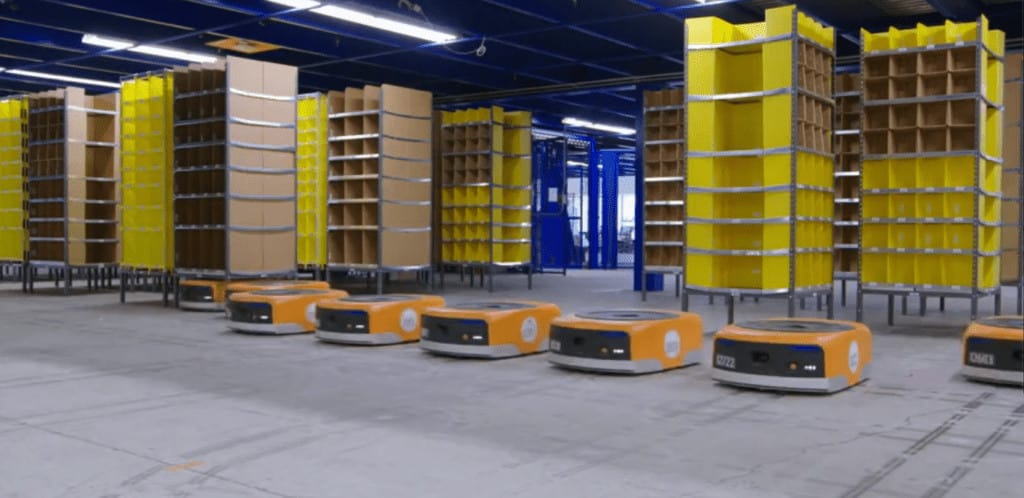Injury Rates Higher in Amazon’s Automated Warehouses
According to a report by Reveal, the rate of serious injuries from 2016 to 2019 was more than 50% higher at warehouses with robots than ones without
- Last Updated Oct 1, 2020

What are the benefits of automation? Well, it can help with consistency, lower operating costs, and, according to Productivity Inc., automation can improve worker safety. “Automated cells remove workers from dangerous tasks,” it said, adding that employees would thank their employers for “safeguarding them against the hazards of a factory environment.”
It’s a believable benefit, and it obviously has some truth to it. But, this week, Reveal from the Center for Investigative Reporting, found that Amazon employees working at Amazon’s automated factories have higher injury rates than those without robots; the opposite of what the company claimed would be the case.
Reveal obtained internal documents as part of a wider investigation of Amazon’s workplace safety and rising injury rates across the country. According to the data, injury rates at Amazon’s robotic warehouses have increased year on year for the past four years. The report found that this is likely thanks to the ramping up of production quotas in automated factories.
At Amazon fulfillment centers used to ship small to medium-sized packages (the most common type of warehouse used by the company), the rate of serious injuries from 2016 to 2019 was more than 50% higher at warehouses with robots than ones without, according to the report.
Reveal heard from a number of Amazon warehouse employees whose accounts matched their findings:
The robots were too efficient. They could bring items so quickly that the productivity expectations for workers more than doubled, according to a former senior operations manager who saw the transformation. And they kept climbing. At the most common kind of warehouse, workers called pickers – who previously had to grab and scan about 100 items an hour – were expected to hit rates of up to 400 an hour at robotic fulfillment centers.
Along with the increase in speed needed to meet the demands of both the company and the robots, repetitive strain injury (RSI) became common among workers, who had gone from walking around a warehouse to standing in one place for 10 hours a day, doing the same task over and over. But this isn’t new.
In 2015, OSHA called out Amazon for exposing employees to “ergonomic risk factors including stress from repeated bending at the waist and repeated exertions, and standing during entire shifts up to 10 hours, four days a week and sometimes including mandatory overtime shifts.” They recommended extra rest breaks and rotating tasks, but Amazon is yet to implement anything of the sort.
A former Amazon safety manager told Reveal that the company became aware of the problems posed by increased automation “within a year or two of introducing the robots,” but were unsure of how to fix things without slowing down. “We realized early on there was an issue” the ex-employee told Reveal. “It was just – you’re already moving that way at light speed, so how do you take a step back and readjust?”
And, in 2018, Amazon safety officials set out to find out why 36% of workers at their DuPont warehouse gave an “unfavorable” response to the question, “Does the safety training match the real-world expectations of your job?” The overwhelming response was that the work “requires me to move too quickly, so I am forced to either cut corners or not make rate.”
The main implications of Reveal’s report are that Amazon is attempting to conceal its growing injury rates from the rest of the world so they don’t have to slow down production (or profits).
Yesterday, Amazon sent a statement to The Verge saying that Reveal’s report was misleading: “The very internal documents [Reveal] claims to have obtained ultimately illustrate one thing—we have a deep focus on the safety of our teams.”
Amazon claims that, because it reports more injuries than other companies in the industry it looks like it has a higher rate of injury. The company said:
Reveal is misinformed regarding an OSHA safety metric that measures days away and restricted or transferred work (known as a DART rate) as something the reporter mistakenly calls a serious incident rate. The reality is that there is no such OSHA or industry “serious incident rate,” and our DART rate is actually supportive of employees as it encourages someone with any type of injury, for example, a small strain or sprain, to stay away from work until they’re better.
However, Reveal says it used the term “Serious Injury Rate” (not “incident”) as a replacement for DART, in order to simplify things for its readers.
Despite investing millions of dollars into protecting the safety of its employees over the years, Amazon has only seen an increase in injury rates every year since 2015.
